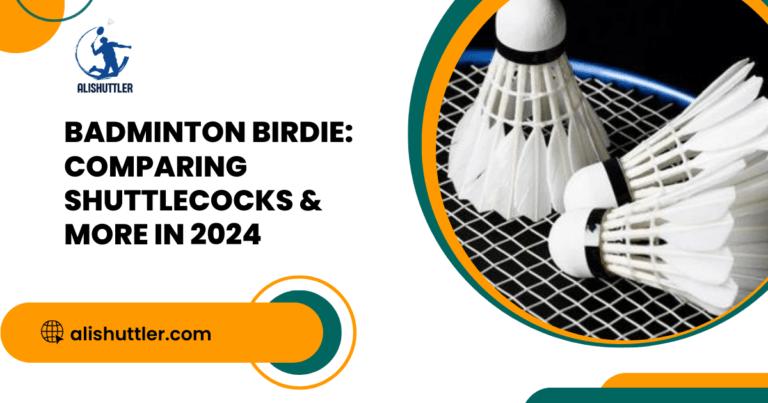Badminton health and safety regulations protect players, coaches, fans, and clubs. Read more about their role in making the game safe, fair and enjoyable in the United States. These regulations reinforce the importance of using the appropriate equipment, including non-marking shoes and safety goggles.
They ensure the courts are safe and clear of potential danger. The rules also include provisions for first aid, emergency action plans, and periodic inspection of equipment safety. In a hall used for indoor games, ventilation and lighting become critical to avoid slips or strain on the eyes.
Most clubs display health and safety regulations, and coaches instruct players in the basics of safe play to reduce injury risk. Knowing these guidelines is the best way for players, coaches, and parents to protect themselves and keep the game fun.
The rest of this post breaks down the scoop on rules, gear, and steps to ensure safe play.
Why Badminton Safety Matters
Badminton safety rules are more than a list of regulations; they are the unsung hero of a great badminton game experience.
Why Badminton Safety Is Important
Injuries can occur in an instant! Statistics indicate that almost 70 per cent of all badminton eye injuries happen in doubles games. The shuttlecock can fly faster than 130 miles per hour! That’s why having the right eye protection, quick reflexes, and understanding safe play is crucial.
Whether players avoid warm-ups or grip improperly, causing wrist issues or muscle strains, there are many ways players can get injured. Over the course of a match—no matter how short—most players will run close to one mile. Proper footwear and protective equipment significantly reduce the chance of slipping, spraining an ankle, or taking a tumble.
These measures ensure that whether you’re a novice or seasoned player, you can spend more time on court and less time sidelined due to injury.
Safety regulations prevent potential injuries while ensuring the game remains fair and engaging for players and spectators alike. Facilities that adhere to national standards in acts such as the Health and Safety at Work Act 1974 help provide a safe atmosphere.
That’s good news for players, trainers, and fans! Routine court, net, and light inspections identify potential hazards before they become a problem. Additional measures, including first-aid kits, emergency exits, and on-site security, contribute to a sense of safety.
Lessons with a trained instructor will teach new players the proper techniques and reduce the risk of overuse injuries. Taking rest intervals in between games and not overexerting yourself early on is a wise decision for your body’s durability over time.
In the long run, following safety guidelines leads to more enjoyable experiences and less injuries for everyone. It expresses appreciation for the sport and one another.
What Are Safety Regulations?
Safety regulations in badminton include guidelines and procedures. They are designed to keep all players and those present near the court safe. These standards serve to maintain the integrity of competitive play, reduce the likelihood of injury, and encourage long-term health.
From our perspective, at their core, these regulations ensure fair court maintenance, equipment inspections, player safety and health standards, and coach training requirements. For instance, courts should be routinely inspected for dangers—such as wet areas, unsecured net posts, or floor depressions.
Athletes must wear specialized shoes designed for badminton to prevent ankle injuries and falls. Clubs emphasize that injured players must be cleared by a medical professional before returning in order to prevent exacerbating injuries.
Recreational play typically employs much looser regulations, emphasizing overall common sense safety advice and good sportsmanship. Competitive matches adhere to tighter regulations such as court inspections prior to matches, mandatory warm-up routines and checks on player fitness level.
Both settings value ongoing education for players, parents, and coaches about staying safe—like including balance and resistance training or making warm-ups part of practice twice a week. Regular annual physicals allow you to catch health risks before they develop into serious issues.
Sleep is important as well; not getting at least eight hours of sleep increases the risk of injury by 70%. Abiding by these guidelines keeps everyone safe, prevents injuries, and demonstrates consideration for the sport.
For consistent and fair gameplay, compliance is key, regardless of competitive prowess.
Global vs. National Standards
| Aspect | Global (BWF) | US National (USA Badminton) |
|---|---|---|
| Court Design | Standard specs worldwide | Often adapted for local gyms |
| Equipment Standards | Strict, detailed | Follows BWF, some flexibility |
| Injury Prevention | Broad guidelines | Specific warm-up, fitness rules |
| Rule Enforcement | International officials | Local refs, club volunteers |
International events often shape local badminton safety rules, pushing US clubs to match global standards while ensuring proper precautions fit local needs and resources.
Why These Regulations Exist
These regulations are here to prevent predictable injuries and ensure that all athletes can participate in a safe environment. Routine inspections and wearing the right equipment can go a long way in reducing danger.
In fact, injury rates can decrease by as much as 50% once players start incorporating balance and resistance training. Safe spaces and transparent regulations go a long way in making newcomers comfortable, too.
Failure to comply with these standards can result in serious legal consequences should an accident occur.
Who Sets the Rules in the US
USA Badminton sets a strong example by developing national safety regulations. Local clubs implement and even exceed them, ensuring that players have safe courts and they are informed of the most up-to-date safety recommendations.
When community input develops policy, everyone—coaches, parents, and players alike—help ensure that they can all continue playing safely.
Your Essential Safety Checklist
An intelligent strategy to badminton entails a complete safety checklist, incorporating badminton safety rules and health considerations. This checklist includes court, equipment, and behavior—everything that keeps players healthy and performing at their best.
- Check personal health and fitness before each game.
- Look at the playing surface for cracks, slippery spots or debris, and loose equipment.
- Test lighting and court space for safe movement.
- Check rackets and shuttlecocks for damage or wear.
- Wear shoes made for badminton to avoid slips.
- Know emergency exits and first aid locations.
- Communicate any health concerns with coaches or teammates.
1. Check Yourself Before You Play
Start by checking in on your health. Muscle soreness, prior muscular injuries, and recent illness can all increase risk. Stretch and do some dynamic movements that loosen up your joints and muscles, preparing your body to start working.
If you are experiencing soreness and/or weakness, discuss with your coach or training group. This ensures the safety and preparedness of all road users.
2. Assess Court Conditions Thoroughly
Inspect the court for potential dangers. Keep badminton floors clean and dry. Look for fissures, pooling water, or debris that might cause someone to fall.
Adequate lighting is essential, particularly in larger gymnasiums. Ensure there is sufficient distance between the lines of travel to proceed without running into walls or equipment.
If something doesn’t seem right, report that to the staff before play starts.
3. Inspect All Your Equipment
Take a close look at your racket—inspect the grip, frame and string tension. Ensure to replace any frayed shuttlecocks.
Badminton shoes provide more traction on courts and surfaces, reducing slip and fall accidents. Develop a gear checklist to make sure you don’t forget anything.
Eye protection – This is a smart precaution, as birdies can travel at speeds up to 130mph.
4. Practice Safe On-Court Conduct
Communicate with your teammates and announce shots loudly. Be mindful of those around you to prevent accidental injuries from runners and walkers colliding with you.
Keep your racket head up for added eye protection. Respect and sportsmanship should be the foundation for any game in a safe environment.
5. Review Safety Measures Post-Game
After playing, discuss what made them feel unsafe. Discuss strategies to improve safety and flag any hazardous equipment or court issues.
Continuous feedback and reflection are at the core of this process.
Core Rules for Safe Play

Safe play in badminton relies on a handful of basic rules that every player must be familiar with. These core rules ensure that first-time players and veterans alike are kept injury-free and make the playing field level.
Being aware, maintaining distance, using equipment properly, and good communication with others—both on the ground and in the air—are all critical. A prioritization of player safety is the best way to ensure everyone remains healthy, thus ensuring the pace and enjoyment of the game remains interesting and competitive.
Maintain Constant On-Court Awareness
As a player, you should have your eyes constantly moving between your teammates and opponents on the court. Wet spots or protruding net poles are examples of hazards that can lead to dangerous slips, so courts should be inspected routinely.
In doubles, communicating with your partner about who’s taking a shot can prevent confusion. When the shuttlecock can zip at speeds over 130mph, anticipation and awareness of court positioning goes a long way. Small rules such as yelling “mine” or “yours” before a play avoids dangerous crashes.
Respect Every Player’s Space
Respect Every Player’s Space Personal space is important in badminton. Players should maintain sufficient distance from other players to prevent racket or body collisions.
This applies in singles and doubles. When a player is about to smash or clear, give them space to make the shot without interference. Respecting these boundaries includes allowing your opponent to reach the shuttlecock without standing in their path.
Handle Your Racket Responsibly
Holding the racket properly protects your wrist from injuries and wild swishes. Teach players the ideal grip and swing path, including how to always keep the racket pointed down when it’s not in use.
This quick routine prevents injuries at any stoppage in play between points. If you’re using the wrong grip, you can hurt yourself. Playing too long without breaks can pose a safety hazard, particularly for those just getting started in the sport.
Call Shots Clearly and Early
Clear calls reduce hesitation and misunderstandings. Announcing “out,” “mine,” or “leave it” allows everyone to respond in an instant if a teammate is in danger.
Early calls, clearly communicated to all players, inform everyone as to what’s happening, helping to ensure play proceeds smoothly and safely. Tactile collaboration depends on clear, consistent communication.
With players sprinting up to one mile per game, they must be on top of their game!
Gear Up for Safety
Choosing the right gear for badminton affects your performance, comfort, and safety on the court. If you’re new to the game or a weekend warrior, having the proper shoes, clothing, and protective gear can significantly reduce the risk of injury. Quality gear protects you at high speeds and allows you to stay in the zone on race day.
If it’s right, you’ll be able to perform at a higher level and will have a reduced chance of injury. Even things like breathable T-shirts or stretchy pants make a difference because they allow you to move and bend without restraint. Choose wisely.
Choosing quality gear makes the difference because it will be more durable and help keep you safe over hours of practice and competition.
Choose Proper Badminton Shoes
Badminton shoes need to provide excellent traction and ankle and lateral support for rapid deceleration and maneuvering. Shoes designed for badminton have non-marking rubber soles that grip to indoor courts, preventing dangerous slips.
The cushioning in the soles is designed to absorb shock and reduce stress on your knees and ankles. Your style of play comes into consideration as well—if you make a lot of moves up at the net, shoes that bend are important to you.
Examine your footwear for broken or smooth soles and frayed seams to ensure you’re sure-footed. If you start to feel a loss of grip, replace them, as an old shoe can cause a rolled ankle or a fall.
Care for Rackets & Shuttles
Cleaning your racket regularly will make it last longer and will prevent gunk from building up on your grip. Rackets need to be stored horizontally and out of direct heat to avoid warping.
Inspect the strings regularly—tight strings provide more control, but if they are too loose, they may break and injure your hand. Those worn out, dinged up shuttlecocks don’t just perform poorly, they put unnecessary strain on your arm.
Replacing them on a timely basis helps to ensure that rallies are safe and continuous.
Consider Optional Protective Gear
Protective eyewear protects against other hazards like high-speed shuttlecocks, which are recorded at over 130 mph. Many players choose to wear wrist guards or elbow pads if they have a history of injury or soreness in those joints.
These are great for protecting wrists—and elbows, if applicable—from hard impacts or falls. Ensure that any supplemental gear is a good fit and comfortable so it doesn’t impede movement.
My Take: Elevating Badminton Safety
It’s not just about the rules. As the sport continues to expand and evolve in the U.S., our approach to understanding safety should advance. Courts around the country, in cities like Los Angeles, are filled with diverse players, kids, and adults alike.
This diversity creates a situation where risks and needs are constantly evolving day to day. Slippery floors, loose net poles, and adequate lighting are just a few hazards that court managers need to regularly inspect. Foot-grip is one of those features you might think is a minor detail—shoes with better grip reduce slips and ankle twists.
Whether you’re a pro or a weekend player, choosing appropriate footwear helps ensure you can move with confidence. Dressing in loose, comfortable clothing is key to preventing injury!
Amateur vs. Pro: Different Safety Needs
Pros face more risk due to intense training, while amateurs might overlook basics like warmups. Pros have strict routines, from injury checks to rest breaks.
Amateurs, though, sometimes skip these steps, raising their chance of sprains or eye injuries—especially from fast serves. It helps for everyone to know and use pro-level habits, like regular gear checks and stretching.
Adapt Safety for Changing Times
With continued research and technology, we can better protect players as the game continues to change. From improved footwear to innovative net designs, being adaptable and open to change is essential.
Every court and club should regularly revisit their safety protocols. This way, they can adapt to the unexpected, such as a flooring overhaul or new health protocols from their city.
Use Smart Tech for Safer Play
Wearable devices can monitor and report heart rate and number of steps, warning athletes when they are overexerting themselves or straining during their badminton game. New apps not only record match play but also identify indicators of fatigue, which is crucial for preventing badminton injuries.
New racquet grips and eyewear further enhance badminton safety rules, reducing risk and making safe play even easier. Incorporating proper technique and warm ups into a training program can also help athletes avoid common injuries associated with this demanding sport.
Address Hidden Ergonomic Risks
When these bad habits—whether it’s poor posture or a stiff swing—accumulate, they increase strain. Strength and stretch routines reduce pain.
Accepting your limitations and being well-rested prevents minor issues from becoming major ones.
Injury Prevention Beyond Basic Rules
Cross-training, rest, and mental prep matter for badminton health. Eye protection, quick court checks, and knowledge of emergency evacuation procedures complete a smart, all-in approach.
Creating Safe Badminton Spaces

Creating safe spaces to play ensures that badminton remains an engaging and equitable sport, emphasizing the importance of badminton safety rules. High-quality courts not only make players of all skill levels feel more welcome but also significantly reduce the chance of badminton injuries. When clubs create spaces that are clean, well-lit, and safe, players can fully immerse themselves in the sport without worrying about inadequate playing surfaces or poor lighting.
Facility managers should regularly ensure that badminton courts, nets, and equipment are well maintained. New court lines and frequent cleaning are essential for minimizing the risk of slipping. A weekly inspection can identify areas with loose floorboards or shuttlecocks that need replacing, reinforcing the need for vigilant maintenance.
Proper lighting and ventilation, through the use of windows and doors, provide athletes with quality vision and air while they play. Easily visible signs with club rules can help remind everyone to keep things safe and stick to the fundamentals.
Facility Safety and Upkeep
Facility upkeep in general begins proactively with regular walkthroughs. This means that courts may need to be mopped and nets adjusted to the appropriate height. Staff are able to identify cracks or loose items on floors.

Consistent guidelines displayed at the facility entrance set a tone of accountability. All of these factors contribute to gameplay. Good lighting equals less missed shots. Fans or open windows provide ventilation, ensuring players don’t become overheated during the game.
The Coach’s Critical Safety Role
Coaches are the most ideal shovelers of the safety culture foundation. They demonstrate to the players how to properly warm-up, stretch and perform balance drills. These interventions can reduce lower-body injuries by up to 50%.
Coaches can help by focusing on racket face protection as a core principle. They should be sure to warn players not to pivot and look back at a teammate’s shot. The point about sleep—we know under 8 hours puts you 70% more likely to get injured—needs to be taught so players can choose wisely.
Implement Regular Hazard Checks
Regular hazard checks help to make clubs the safest space possible. Anyone can identify an issue—a damp area, frayed tape, or faulty bulb. Players need to have the confidence to raise their concerns.
If everyone pitches in, the entire community is less vulnerable. Open dialogue about hazard spotting fosters trust and can lead to quick resolution of issues.
Develop Emergency Action Plans
Every club should have an action plan outlining response procedures in the event of an emergency. Ensuring that staff and players are aware of the locations of first aid kits, emergency contacts, and how to call for emergency support are critical steps.
These short exercises allow everyone to move efficiently and effectively when real emergencies do occur. These easy-to-read guides as well as team-oriented chats and check-ins ensure communication is always open.
Conclusion
To play badminton safely, keep to the fundamentals. Examine the court for any loose floors, wet spots, etc. Choose proper footwear and protective equipment. Follow the regulations, and stay vigilant to your environment and other people’s spaces. Keep your eyes peeled, warm up before you hit the court, and don’t be afraid to raise the alarm if you notice a hazard. Even a minor repair, such as taping down a loose net cord, can prevent a serious sprained ankle.
Courts in the U.S. Have well defined standards. Most gyms are diligent in keeping tight courts, but it never hurts to verify. Looking to continue the fun beyond today? Help us keep this knowledge to ourselves. Influence your friends and the next-generation players to develop good habits. After all, safety is a shared responsibility—let’s all do our part to ensure everyone arrives safely.
Frequently Asked Questions
What are the main health and safety regulations for badminton in the U.S.?
USA Badminton safety guidelines emphasize the importance of warming up and cooling down, which are key badminton health practices to prevent common injuries and ensure proper court setup and clear playing areas.
Why is it important to wear proper badminton shoes?
Proper badminton shoes are essential for maintaining a good grip and support, helping to prevent common injuries such as ankle sprains and knee injuries on polished gymnasium floors.
How can I prevent injuries while playing badminton?
Taking precautions such as warming up before you play, following badminton safety rules, using appropriate gear, staying hydrated, and playing safely can help prevent common badminton injuries. Listen to your body and take breaks if you experience pain.
What should I check before setting up a badminton court?
Ensure the badminton courts are free from debris and completely dry, as proper lighting is essential for safety and visibility, adhering to badminton safety rules to prevent common injuries during play.
Are there age-specific safety guidelines for youth badminton players?
Yes. Children players must use age-appropriate rackets, wear protective eyewear, and follow badminton safety rules with constant adult supervision while practicing and playing.
How often should badminton equipment be checked for safety?
Check badminton equipment safety by inspecting rackets, shuttlecocks, nets, and shoes at the start of each session. Proper precautions help prevent badminton injuries, so immediately replace any damaged or unsafe gear.
What should I do if someone gets injured during a game?
Pause play right away to assess any potential badminton injuries, determine the nature of the injury, and apply first aid. Call for medical assistance if the injury is severe and report any accident to facility staff.






